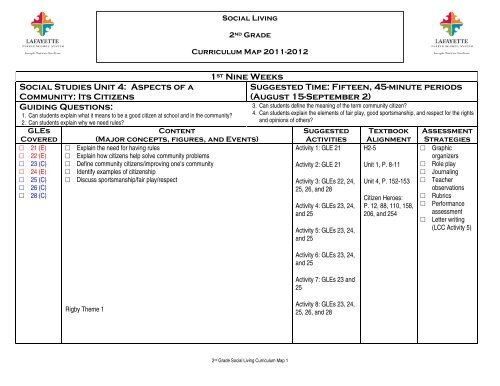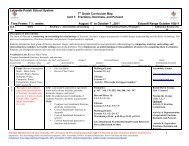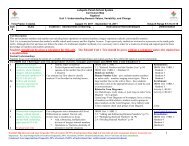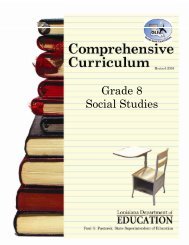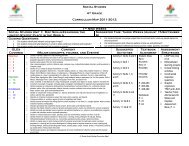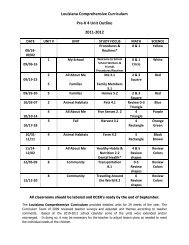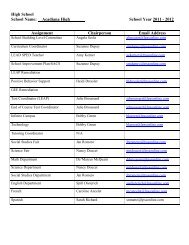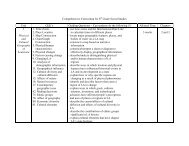2nd Grade Curriculum Map 2011-12 - Lafayette Parish School System
2nd Grade Curriculum Map 2011-12 - Lafayette Parish School System
2nd Grade Curriculum Map 2011-12 - Lafayette Parish School System
- No tags were found...
You also want an ePaper? Increase the reach of your titles
YUMPU automatically turns print PDFs into web optimized ePapers that Google loves.
Social Living2 nd <strong>Grade</strong><strong>Curriculum</strong> <strong>Map</strong> <strong>2011</strong>-20<strong>12</strong>Social Studies Unit 4: Aspects of aCommunity: Its CitizensGuiding Questions:1. Can students explain what it means to be a good citizen at school and in the community?2. Can students explain why we need rules?GLEsCovered□ 21 (E)□ 22 (E)□ 23 (C)□ 24 (E)□ 25 (C)□ 26 (C)□ 28 (C)Content(Major concepts, figures, and Events)□ Explain the need for having rules□ Explain how citizens help solve community problems□ Define community citizens/improving one’s community□ Identify examples of citizenship□ Discuss sportsmanship/fair play/respect1 st Nine WeeksSuggested Time: Fifteen, 45-minute periods(August 15-September 2)3. Can students define the meaning of the term community citizen?4. Can students explain the elements of fair play, good sportsmanship, and respect for the rightsand opinions of others?SuggestedActivitiesActivity 1: GLE 21Activity 2: GLE 21Activity 3: GLEs 22, 24,25, 26, and 28Activity 4: GLEs 23, 24,and 25Activity 5: GLEs 23, 24,and 25Activity 6: GLEs 23, 24,and 25Activity 7: GLEs 23 and25TextbookAlignmentH2-5Unit 1, P. 8-11Unit 4, P. 152-153Citizen Heroes:P. <strong>12</strong>, 88, 110, 158,206, and 254AssessmentStrategies□ Graphicorganizers□ Role play□ Journaling□ Teacherobservations□ Rubrics□ Performanceassessment□ Letter writing(LCC Activity 5)Rigby Theme 1Activity 8: GLEs 23, 24,25, 26, and 282 nd <strong>Grade</strong> Social Living <strong>Curriculum</strong> <strong>Map</strong> 1
Social Living2 nd <strong>Grade</strong><strong>Curriculum</strong> <strong>Map</strong> <strong>2011</strong>-20<strong>12</strong>Social Studies Unit 2: Aspects of aCommunity: Its GeographyGuiding Questions:1. Can students use cardinal directions to locate places on maps and globes?2. Can students describe the physical characteristics of the community?3. Can students describe the human characteristics of the community?GLEsCovered□ 1 (I)□ 2 (I)□ 3 (E)□ 4 (E)□ 5 (I)□ 6 (I)□ 7 (E)□ 8 (E)□ 9 (I)□ 10 (I)□ 11 (I)□ <strong>12</strong> (I)□ 13 (I)□ 14 (E)□ 15 (C)Content(Major concepts, figures, and Events)□ Interpret a diagram□ Describe maps and globes□ Use cardinal directions□ Identify geographical features□ Construct a bar graph□ Sketch a map related to the classroom, school, or community□ Identify landforms□ Discuss climate□ Identify demographic graphs of a region□ Identify ways to make a living□ Discuss the role of weather, land, and water in food production□ Describe how location, weather, and physical environment affect where and howpeople live□ Characteristics of a community□ Changes in the local community□ Types of settlement and patterns of land use□ How physical environment will satisfy basic needsRigby Themes 5 and 61 st Nine WeeksSuggested Time: Thirteen, 45-minute periods(September 6-September 23)4. Can students explain how the physical environment satisfies basic needs?5. Can students describe the impact of climate on vegetation of the local community?SuggestedActivitiesActivity 1: GLEs 2, 3, and 6Activity 2: GLEs 1 and 2Activity 3: GLEs 2, 3, and 8Activity 4: GLE 8Activity 5: GLEs 3 and 4Activity 6: GLEs 11, 15, and37Activity 7: GLEs 6, 7, 9, and10Activity 8: GLEs 5 and 9Activity 9: GLE <strong>12</strong>Activity 10: GLEs 7, 10, 14Activity 11: GLEs 5 and 13Activity <strong>12</strong>: GLEs 7, 15, and37Activity 13: GLEs 3, 7,15TextbookAlignmentH18-H19P. 16-21P. 24-27P. 30-33P. 36-39P. 56-67P. 76-79P. 80-81P. 1<strong>12</strong>-115P. <strong>12</strong>4-<strong>12</strong>5P. 184-185P. 214-215Workbook:P. 5P. 7P. 9P. 14P. 16P. 28P. 30P. 45P. 53AssessmentStrategies□ Create maps(LCC Activity 5)□ Bar graphs(LCC Activity 8)□ Read a map(LCC Activity 5)□ Journal writing(LCC Activity 7)□ Paragraphassessment□ Portfolioassessment□ Rubric (LCCActivities 4 and9)2 nd <strong>Grade</strong> Social Living <strong>Curriculum</strong> <strong>Map</strong> 2
Social Living2 nd <strong>Grade</strong><strong>Curriculum</strong> <strong>Map</strong> <strong>2011</strong>-20<strong>12</strong>Science Unit 5: Earth and BeyondGuiding Questions:1. Do students understand the difference among rocks, minerals, and soil?2. Can students identify bodies of water such as lakes, oceans, seas, and rivers?GLEsCovered□ 1 (E)□ 2 (E)□ 3 (E)□ 5 (E)□ 6 (E)□ 9 (E)□ 10 (E)□ 11 (E)□ <strong>12</strong> (I)□ 36 (E)□ 37 (E)□ 38 (E)□ 42 (C)□ 43 (E)□□□□□□□□□□□□□□Content(Major concepts, figures, and Events)Ask questions about objects and events in the environment (i.e., plants, rocks, storms, etc.)Pose questions that can be answered by using students’ own observations, scientific knowledge, andscientific investigationsUse observations to design and conduct simple investigations or experiments to answer testablequestionsUse a variety of methods, materials, and multiple trials to investigate ideas (i.e., observe, measure,accurately record data)Use the five senses to describe observationsExpress data in a variety of ways by constructing illustrations, graphs, charts, table concept maps, andoral/written explanations as appropriateUse a variety of appropriate formats to describe procedures and to express ideas aboutdemonstrations and/or experimentsIdentify safety procedures and equipment when conducting investigationsRecognize that a variety of tools can be used to examine objects (i.e., magnification)Properties of rocks, minerals, and soils gathered from surroundingsCompare bodies of water found on EarthExplain why most of the water on Earth cannot be used for drinkingTools to gather and study rocks, minerals, and fossilsDescribe characteristics of the sun, stars, Earth, and moonScience as Inquiry GLEs repeat in most units. It is important to cover these skills in each unit they appear.1. Ask questions about objects and events in the environment2. Pose questions3. Conduct simple investigations to answer testable questions4. Predict possible outcomes5. Use a variety of methods to investigate ideas6. Use the 5 senses7. Measure and record length and temperature in both metric and U.S. system units8. Select appropriate equipment and tools to observe and collect data9. Express data in a variety of ways10. Use a variety of formats to describe procedures11. Safety proceduresRigby Themes 3 and 41 st Nine WeeksSuggested Time: Ten, 45-minute periods(September 26-October 7)2 nd <strong>Grade</strong> Social Living <strong>Curriculum</strong> <strong>Map</strong> 33. Can students describe the major objects in the sky, such as the Sun, stars, and Moon,and make a comparison of their characteristics?SuggestedActivitiesActivity 1: GLEs 1, 3, 5,6, 9, 11, <strong>12</strong>, 36, and 42Activity 2: GLEs 2, 6, 9,37, and 38Activity 4: GLEs 2, 9,10, and 43TextbookAlignmentRocks andMinerals, pg. 204-211Soil, pg. 2<strong>12</strong>-219Earth’s Water, pg.220-227Moon and Stars,pg. 228-237I Read to Review,pg. 238-241Unit 5 Review, pg.242-245AssessmentStrategies□ Graphicorganizers (LCCActivity 4)□ Data collectioncharts (LCCActivity 1)□ Learningprojects□ Teacher createdchecklist□ Portfolio
Social Living2 nd <strong>Grade</strong><strong>Curriculum</strong> <strong>Map</strong> <strong>2011</strong>-20<strong>12</strong>1 st and 2 nd Nine WeeksSocial Studies Unit 1: Aspects of aSuggested Time: Fourteen, 45-minute periodsCommunity: Its History(October 10-October 31)Guiding Questions:3. Can students describe how people changed their environment and how the environment1. Can students discuss who lives in the community now and who lived there in the past?affects the people?2. Can students describe how the people and the community have changed over time?GLEsCovered□ 10 (I)□ 45 (E)□ 46 (I)□ 47 (E)□ 48 (I)□ 49 (E)□ 50 (E)Content(Major concepts, figures, and Events)□ Describe changes in characteristics of local community and environment over time□ Develop a personal timeline□ Identify historical resources□ Locate areas on maps and globes□ Compare and contrast past to present time□ Identify landmarks and symbolsSuggestedActivitiesActivity 1: GLE 45Activity 2: GLEs 10, 46,and 49Activity 6: GLE 46, 47,48Activity 8: GLE 48 and50TextbookAlignmentUnit 6: P. 264-276P. 272-275P. 226P. 22-23Workbook:P. 42P. 50P. 52P. 54P. 55P. 65P. 66AssessmentStrategies□ Rubric fortimeline (LCCActivity 1)□ Paragraphassessments□ Portfolioassessment□ Journal writing□ Poster/collage(LCC Activity 8)Rigby Theme 2Textbook additionalreading:P. 142-175P. 202-205P. 210-213P. 216-219P. 221-2252 nd <strong>Grade</strong> Social Living <strong>Curriculum</strong> <strong>Map</strong> 4
Social Living2 nd <strong>Grade</strong><strong>Curriculum</strong> <strong>Map</strong> <strong>2011</strong>-20<strong>12</strong>2 nd Nine WeeksScience Unit 1: Properties of Matter Suggested Time: Eighteen, 45-minute periods(November 1-December 2)Guiding Questions:3. Can students select the appropriate tools to measure the length of an object?1. Can students select appropriate words to describe the properties of matter, including the4. Can students determine and record the temperature in °C and °F?terms rigid and bendable?2. Can students explain what would cause a pan balance to go up on one side and down on theother?GLEsCovered□ 2 (E)□ 3 (E)□ 4 (E)□ 5 (E)□ 6 (E)□ 7 (E)□ 8 (I)□ 9 (E)□ 10 (E)□ 11 (E)□ <strong>12</strong> (I)□ 14 (E)□ 15 (I)□ 16 (E)□ 17 (I)□ 18 (E)□ 20 (C)□ 25 (C)Content(Major concepts, figures, and Events)□ Introduction to matter□ Classify objects as bendable or rigid□ Record temperature in Celsius and Fahrenheit□ Measure weight/mass and volume by using a pan balance□ Use standard tools to measure objects□ Observe, describe, and record the characteristics of materials that make up objects□ Observe, describe, and record the differences in motion between objects□ Investigate ways to produce static electricity and its effectsScience as Inquiry GLEs repeat in most units. It is important to cover these skills in each unit they appear.<strong>12</strong>. Ask questions about objects and events in the environment13. Pose questions14. Conduct simple investigations to answer testable questions15. Predict possible outcomes16. Use a variety of methods to investigate ideas17. Use the 5 senses18. Measure and record length and temperature in both metric and U.S. system units19. Select appropriate equipment and tools to observe and collect data20. Express data in a variety of ways21. Use a variety of formats to describe procedures22. Safety proceduresSuggestedActivitiesActivity 1: GLEs 2, 6, 9,10, 14, and 18Activity 2: GLEs 9, 14,and 18Activity 3: GLEs 4, 5,10, and 16Activity 4: GLEs 3, 5, 6,7, 8, 9, 10, and 17Activity 5: GLEs 7, 8,11, <strong>12</strong>, 17, and 18Activity 6: GLEs 3, 6,and 20Activity 7: GLEs 2 and25TextbookAlignmentDescribing Matter,pg. 22-31Liquids and Gases,pg. 32-39Position andMotion, pg. 40-49Measurement, pg.R4 and R5I Read to Review,pg. 50-53Unit 1 Review, pg.54-57AssessmentStrategies□ Checklist□ Drawings□ Charts□ Photographs□ T-chart (LCCActivity 3)□ Recordingsheets (LCCActivity 4)□ Investigationparticipation(LCC Activity 8)Rigby Theme 7Activity 8: GLEs 2, 3, 4,5, 6, 7, 11, and 152 nd <strong>Grade</strong> Social Living <strong>Curriculum</strong> <strong>Map</strong> 5
Social Living2 nd <strong>Grade</strong><strong>Curriculum</strong> <strong>Map</strong> <strong>2011</strong>-20<strong>12</strong>2 nd Nine WeeksSocial Studies Unit 6: The World and Local Suggested Time: Twelve, 45-minute periodsCultures and Customs(December 5-December 20)Guiding Questions:3. Can students explain the meanings to our national holidays?1. Can students describe folktales, legends, and stories of heroism that tell about historyand traditions?2. Can students explain some customs of other cultures and how they resemble ours?GLEsCovered□ 1 (I)□ 2 (I)□ 3 (E)□ 8 (E)□ 27 (I)□ 45 (E)□ 48 (I)□ 51 (I)□ 52 (E)Content(Major concepts, figures, and Events)□ Interpret a diagram□ Describe characteristics of maps and globes□ Use cardinal directions to locate places□ Identify various landforms (i.e., continents and islands)□ Explain the significance of national holidays and the achievements of the peopleassociated with them□ Develop a personal timeline□ Locate areas on maps and globes referenced in stories and legends□ Identify cultural elements of the local community□ Explain customs related to holidays and ceremonies in various countries around theworldSuggestedActivitiesActivity 2: GLEs 2, 8,51, and 52Activity 4: GLEs 3 and52Activity 5: GLEs 1, 48,and 51Activity 7: GLEs 27, 45,and 52TextbookAlignmentP. 40-41P. <strong>12</strong>4-<strong>12</strong>5P. 256-259P. 270-271P. 273Workbook P. 30AssessmentStrategies□ Graphicorganizers□ Journal writing□ Teacherobservations□ Venn diagram(LCC Activity 2)□ Collage/poster(LCC Activity 4)Rigby Theme 82 nd <strong>Grade</strong> Social Living <strong>Curriculum</strong> <strong>Map</strong> 6
Social Living2 nd <strong>Grade</strong><strong>Curriculum</strong> <strong>Map</strong> <strong>2011</strong>-20<strong>12</strong>2 nd and 3 rd Nine WeeksSocial Studies Unit 3: Aspects of aSuggested Time: Sixteen, 45-minute periodsCommunity: Its Government(January 4-January 27)Guiding Questions:3. Can students explain how our community is governed?1. Can students explain why we need local government?2. Can students explain who is in charge of our community?GLEsCovered□ 16 (I)□ 17 (E)□ 18 (I)□ 19 (I)□ 20 (I)□ 43 (I)Content(Major concepts, figures, and Events)□ Identify community and parish laws and the persons responsible for makingand enforcing them□ Identify the importance of local government and how it meets the needs ofsociety□ Describe responsibilities of local government (making laws, paving roads,planting trees, etc.)□ Identify local government positions, their powers, and limits on their powers□ Explain how government officials are elected□ Identify goods and services provided by the local governmentSuggestedActivitiesActivity 2: GLEs 16,17, 18, and 19Activity 3: GLEs 17,18, and 19Activity 4: GLEs 17and 43Activity 6: GLEs 16,17, 18, 19, and 43Activity 8: GLE 20TextbookAlignmentP. 154-163P. 166-169P. 180-183P. 260-261Workbook:P. 36P. 38P. 39P. 44AssessmentStrategies□ Role playing□ Journal (LCCActivity 3)□ Posters□ Rubric□ Paragraphs(LCC Activity4)Rigby Themes 9 and 102 nd <strong>Grade</strong> Social Living <strong>Curriculum</strong> <strong>Map</strong> 7
Social Living2 nd <strong>Grade</strong><strong>Curriculum</strong> <strong>Map</strong> <strong>2011</strong>-20<strong>12</strong>Science Unit 2: Sound and LightGuiding Questions:1. Can students explain how sounds are made?2. Can students describe how sound travels?GLEsCovered□ 2 (E)□ 3 (E)□ 4 (E)□ 9 (E)□ 10 (E)□ 13 (I)□ 21 (C)□ 22 (C)□ 23 (C)□ 24 (E)□ 26 (C)□□□□□□□□□□□Content(Major concepts, figures, and Events)Pose questions that can be answered by students’ own observations, scientific knowledge,and testable scientific investigationsUse observations to design and conduct simple investigations or experiments to answertestable questionsPredict and anticipate possible outcomesExpress data in a variety of ways by constructing illustrations, graphs, charts, tables,concept maps, and oral and written explanations as appropriateUse a variety of appropriate formats to describe procedures and to express ideas aboutdemonstrations or experimentsExplain and give examples of how scientific discoveries have affected societyUse students own voices to demonstrate pitchGive examples of objects that vibrate to produce soundChange the direction of light by using a mirror and/or lensDescribe how light behaves when it strikes objects and materialsIdentify and describe sources of energy used at school, home, and playScience as Inquiry GLEs repeat in most units. It is important to cover these skills in each unit they appear.23. Ask questions about objects and events in the environment24. Pose questions25. Conduct simple investigations to answer testable questions26. Predict possible outcomes27. Use a variety of methods to investigate ideas28. Use the 5 senses29. Measure and record length and temperature in both metric and U.S. system units30. Select appropriate equipment and tools to observe and collect data31. Express data in a variety of ways32. Use a variety of formats to describe procedures33. Safety procedures3 rd Nine WeeksSuggested Time: Fifteen, 45-minute periods(January 30-February 17)3. Can students describe how light travels?4. Can students describe the appearance of objects that let light shine through?SuggestedActivitiesActivity 2: GLEs 2, 3,4, 10, and 22Activity 3: GLEs 2, 4,10, 21, and 22Activity 6: GLEs 2, 3,4, and 24Activity 8: GLEs 4, 9,10, and 23Activity 9: GLEs 10,13, and 26TextbookAlignmentUsing Energy,pg. 60-69Sound, pg. 70-79Light, pg. 80-87Energy Poem,pg. 88-91Unit 2 Review,pg. 92-95Hand Lens,pg. R6AssessmentStrategies□ Log entry(LCC Activities2 and 3)□ Teacherrecordedobservations□ Teacherchecklist□ Writingactivity/MirrorMagic (LCCActivity 8)Rigby Themes 11 and <strong>12</strong>2 nd <strong>Grade</strong> Social Living <strong>Curriculum</strong> <strong>Map</strong> 8
Social Living2 nd <strong>Grade</strong><strong>Curriculum</strong> <strong>Map</strong> <strong>2011</strong>-20<strong>12</strong>Social Studies Unit 5: Aspects of aCommunity: Its EconomicsGuiding Questions:1. Can students describe basic needs and how we meet them?2. Can students describe who provided goods and services?3. Can students describe the roles of farmers, processors, and distributors in production andconsumption?GLEsCovered□ 14 (E)□ 29 (E)□ 30 (C)□ 31 (I)□ 32 (E)□ 33 (E)□ 34 (C)□ 35 (C)□ 36 (C)□ 37 (I)□ 38 (I)□ 39 (I)□ 40 (I)□ 41 (I)□ 42 (I)□ 44 (E)Content(Major concepts, figures, and Events)□ Identify ways to make a living□ Explain basic human needs (i.e., food, clothing, shelter)□ Identify choices families make when buying goods and services□ Identify a consumer and a producer□ Explain how people depend on each other for goods and services□ Describe the role of farmers, processors, and distributors in food productionand consumption□ Explain why people exchange goods and services□ Identify the work people do to manufacture, transport, and market goods andservicesRigby themes 13 and 143 rd Nine WeeksSuggested Time: Sixteen, 45-minute periods(February 23-March 16)4. Can students identify the bank as a local economic institution?5. Can students identify a consumer and producer and their roles in the community?6. Can students describe ways in which resources are used?SuggestedActivitiesActivity 1: GLEs 29, 34,41, and 42Activity 3: GLEs 14 and 39Activity 4: GLEs 34, 41,and 44Activity 5: GLEs 33, 35,36, 37, and 38Activity 6: GLEs 29, 33,35, 36, 37, and 38Activity 7: GLEs 31 and 32Activity 9: GLEs 36 and 38Activity 10: GLEs 38 and42Activity <strong>12</strong>: GLE 40Activity 13: GLE 30, 35,and 37TextbookAlignmentP. 68-73P. 104-107P. 1<strong>12</strong>-115P. <strong>12</strong>0-<strong>12</strong>3P. <strong>12</strong>6-131P. 134-139Workbook:P. 17P. 26P. 28P. 29P. 31P. 32P. 33AssessmentStrategies□ Journals□ Teacherobservation□ Studentcreatedprojects (LCCActivity 4)□ Vocabularycards (LCCActivity 5)□ Paragraphwriting (LCCActivity 7)□ Student madebook-seerubric (LCCActivity 9)2 nd <strong>Grade</strong> Social Living <strong>Curriculum</strong> <strong>Map</strong> 9
Social Living2 nd <strong>Grade</strong><strong>Curriculum</strong> <strong>Map</strong> <strong>2011</strong>-20<strong>12</strong>4 th Nine WeeksScience Unit 6: WeatherSuggested Time: Ten, 45-minute periods(March 19-March 30)Guiding Questions:1. Can students identify and read the weather instruments used to measure the temperature,wind direction, and rainfall amounts?GLEsCovered□ 1 (E)□ 2 (E)□ 3 (E)□ 4 (E)□ 5 (E)□ 6 (E)□ 7 (E)□ 8 (I)□ 9 (E)□ 10 (E)□ 11 (E)□ <strong>12</strong> (I)□ 19 (E)□ 39 (I)□ 40 (I)□ 41 (I)□ 44 (E)Content(Major concepts, figures, and Events)□ Describe what remains after water evaporates from a salt or sugar solution□ Design an experiment involving evaporation□ Gather, record, and graph weather data□ Record daily temperature and weather conditions□ Give examples of how the Sun affects Earth’s processesScience as Inquiry GLEs repeat in most units. It is important to cover these skills in each unit they appear.34. Ask questions about objects and events in the environment35. Pose questions36. Conduct simple investigations to answer testable questions37. Predict possible outcomes38. Use a variety of methods to investigate ideas39. Use the 5 senses40. Measure and record length and temperature in both metric and U.S. system units41. Select appropriate equipment and tools to observe and collect data42. Express data in a variety of ways43. Use a variety of formats to describe procedures44. Safety proceduresRigby Theme 152. Can students describe the importance and impact the Sun has on weather conditions?SuggestedActivitiesActivity 1: GLEs 2, 7,8, 9, 10, 40, and 41Activity 2: GLEs 1, 3,4, 8, 9, and 39Activity 3: GLEs 4, 5,10, 11, <strong>12</strong>, and 19Activity 4: GLEs 1, 2,4, 5, 6, 10, and 44TextbookAlignmentWeather,pg. 248-255The Sun,pg. 256-263Temperature,pg. R5Graphs, pg. R7AssessmentStrategies□ Wind vanes(LCC Activity1)□ Rain gauges□ Thermometers□ Graphs (LCCActivity 1)□ BLMs (LCCActivity 2)□ Group Projects(LCC Activity4)2 nd <strong>Grade</strong> Social Living <strong>Curriculum</strong> <strong>Map</strong> 10
Social Living2 nd <strong>Grade</strong><strong>Curriculum</strong> <strong>Map</strong> <strong>2011</strong>-20<strong>12</strong>4 th Nine WeeksScience Unit 3: Basic Needs of Living Things Suggested Time: Sixteen, 45-minute periods(April 2-26)Guiding Questions:4. Can students explain the role of the Sun to living things?1. Can students distinguish and describe what makes a living thing and what makes a nonliving5. Can students illustrate and interpret a simple food chain?thing?6. Can students describe a variety of life cycles?2. Can students articulate why food is important to living things?3. Can students explain the functions of the major parts of a plant?GLEsCovered□ 1 (E)□ 2 (E)□ 5 (E)□ 6 (E)□ 8 (I)□ 9 (E)□ 10 (E)□ 11 (E)□ 27 (E)□ 28 (E)□ 29 (I)□ 30 (I)□ 31 (I)□ 32 (C)□ 33 (E)□ 45 (I)□ 46 (E)□ 47 (E)Content(Major concepts, figures, and Events)□ Match food sources and animals□ Describe structures of plants□ Compare differences and similarities of seed plants□ Identify characteristics of organisms□ Identify and discuss the food pyramid□ Analyze a menu to determine if all food groups are represented□ Compare the life cycles of organisms□ Identify plants and animals in the ecosystem□ Illustrate and describe a simple food chain□ Identify the Sun as the primary energy source in a food chainScience as Inquiry GLEs repeat in most units. It is important to cover these skills in each unit they appear.45. Ask questions about objects and events in the environment46. Pose questions47. Conduct simple investigations to answer testable questions48. Predict possible outcomes49. Use a variety of methods to investigate ideas50. Use the 5 senses51. Measure and record length and temperature in both metric and U.S. system units52. Select appropriate equipment and tools to observe and collect data53. Express data in a variety of ways54. Use a variety of formats to describe procedures55. Safety proceduresRigby Theme 162 nd <strong>Grade</strong> Social Living <strong>Curriculum</strong> <strong>Map</strong> 11SuggestedActivitiesActivity 1: GLEs 1, 2,6, 9, and 10Activity 2: GLEs 1, 2,6, and 27Activity 3: GLEs1, 2,9, 28, and 29Activity 4: GLEs 1, 2,6, 9, 45, 46, 47Activity 5: GLEs 1, 2,6, 8, 10, 11, and 45Activity 6: GLEs 5, 9,31, and 32Activity 7: GLEs 1, 2,5, 6, 9, 10, 30, and 33TextbookAlignmentPlants and TheirParts, pg. 98-107Animal Groups, pg.98-107Animals Grow andChange, pg. 116-<strong>12</strong>5Places to Live, pg.<strong>12</strong>6-133Food Chains andFood Webs, pg. 134-143I Read to Review, pg.144-147Unit 3 Review, pg.148-151Food Pyramid, pg.R<strong>12</strong>-R13AssessmentStrategies□ Observation□ Teachercreatedchecklist□ Data collectioncharts□ Experiments□ Animal habitat(LCC Activity2)□ Learning logs(LCC Activities2, 4, 6, and 7)□ PerformanceAssessment(LCC Activity7)
Social Living2 nd <strong>Grade</strong><strong>Curriculum</strong> <strong>Map</strong> <strong>2011</strong>-20<strong>12</strong>4 th Nine WeeksScience Unit 4: EnvironmentSuggested Time: Fourteen, 45-minute periods(May 1-18)Guiding Questions:3. Can students explain what the term endangered animal means and cite examples?1. Can students describe conditions within a habitat that are beneficial for living things and thosethat are not good for living things?2. Can students generate examples of uncontrollable conditions and events that can happenresulting in damage to a habitat?GLEsCovered□ 1 (E)□ 2 (E)□ 3 (E)□ 4 (E)□ 5 (E)□ 6 (E)□ 8 (I)□ 9 (E)□ 10 (E)□ 11 (E)□ 13 (I)□ 34 (E)□ 35 (E)□ 48 (I)□ 49 (I)□ 50 (E)□ 51 (E)□□□□□□□□□□□□□□□Content(Major concepts, figures, and Events)Ask questions about objects and events in an environmentPose questions that can be answered using students’ own observationsUse observations to design and conduct simple investigationsPredict and anticipate possible outcomesInvestigate ideasUse the five senses to describe observationsSelect and use developmentally appropriate equipment, tools, and units of measurement toobserve/collect dataExpress data in a variety of ways by constructing illustrations, graphs, charts, tables and concept mapsUse a variety of appropriate formats to describe procedures and to express ideas aboutdemonstrations or experimentsExplain and give examples of how scientific discoveries affect societyDescribe inherited characteristics of living thingsIdentify the components of a variety of habitats and describe how organisms in that habitat liveDescribe a variety of activities to preserve the environment (i.e., reduce the consumption of resourcesthrough recycling, reusing, conserving)Describe habitat loss or changes through natural eventsGive examples of threatened or endangered speciesScience as Inquiry GLEs repeat in most units. It is important to cover these skills in each unit they appear.56. Ask questions about objects and events in the environment57. Pose questions58. Conduct simple investigations to answer testable questions59. Predict possible outcomes60. Use a variety of methods to investigate ideas61. Use the 5 senses62. Measure and record length and temperature in both metric and U.S. system units63. Select appropriate equipment and tools to observe and collect data64. Express data in a variety of ways65. Use a variety of formats to describe procedures66. Safety proceduresSuggestedActivitiesActivity 1: GLEs 1, 5,6, 9, 10, and 35Activity 2: GLEs 3, 5,6, 11, and 50Activity 3: GLEs 1, 2,4, 8, 9, 48, and 49Activity 4: GLEs 1, 2,4, 9, 10, 13, 34, and51TextbookAlignmentLand Habitats,pg. 154-165Water Habitats,pg. 166-173Habitats Change,pg. 174-183Using Earth’sResources, pg.184-193I Read to Review,pg. 194-197Unit 4 Review,pg. 198-201AssessmentStrategies□ Journals□ Portfolios□ Checklist ofskills□ Data collectioncharts□ Reports□ Writing activity(LCC Activity1)□ Trashsculptures(LCC Activity3)2 nd <strong>Grade</strong> Social Living <strong>Curriculum</strong> <strong>Map</strong> <strong>12</strong>
Social Living2 nd <strong>Grade</strong><strong>Curriculum</strong> <strong>Map</strong> <strong>2011</strong>-20<strong>12</strong>Resources□ Social Studies Unit 1: Aspects of a Community: Its Historyo United Streaming Videos• Long Ago, Yesterday, and Today (15 minutes)• How Customs and Heritage Shape Communities (16 minutes)• How Communities Grow and Change (15 minutes)• How Communities Grow and Change, 2 nd Edition (21 minutes)o Promethean Planet• Features of a Local Community• Past and Present• What Was It Like: Past and Present• Clothes of Long Agoo Websites• http://accessgenealogy.com/native/louisiana Louisiana Indian Tribes (Goes with Activity 6)• http://www.forttours.com/pages/hmscla.asp Historical Markers by <strong>Parish</strong> (Goes with Activity 8)□ Social Studies Unit 2: Aspects of a Community: Its Geographyo United Streaming Videos• Beginning <strong>Map</strong>s: Models and Places (15 minutes)• Understanding <strong>Map</strong>s: Key to Everywhere (15 minutes)• Understanding and Making <strong>Map</strong>s: An Introduction (19 minutes)• <strong>Map</strong>s and Globes: Globes and Their Uses (13 minutes)• Geographical Features: Landforms (18 minutes)• How Communities are Alike or Different (15 minutes)o Promethean Planet• <strong>Map</strong>s-Globe Skills• Neighborhood• Parts of a <strong>Map</strong>• <strong>Map</strong>s• Careers2 nd <strong>Grade</strong> Social Living <strong>Curriculum</strong> <strong>Map</strong> 13
Social Living2 nd <strong>Grade</strong><strong>Curriculum</strong> <strong>Map</strong> <strong>2011</strong>-20<strong>12</strong>□ Social Studies Unit 2: Aspects of a Community: Its Geography (Continued)o Websites• http://teachers.net/gazette/DEC02/continents.html Continents Tour (Goes with Activity 3)• http://factmonster.com (Goes with Activity 4, Physical Geography and Climate)o Smart Board Activities• How to Read <strong>Map</strong>s□ Social Studies Unit 3: Aspects of a Community: Its Governmento United Streaming Videos• This is Our Government (18 minutes)• A Sharing Story (<strong>12</strong> minutes)o Promethean Planet• Constitution Day• President’s Day• Branches of Government• First <strong>Grade</strong> Economics• Goods vs. Services• Features of a Local Governmento Websites• http://www.usconstitution.net/constkidsK.html The Constitution for Kids (Goes with Activity 2)• http://bensguide.gpo.gov/3-5/election/president.html The Election of the President (Goes with Activity 8)□ Social Studies Unit 4: Aspects of a Community: Its Citizenso United Streaming Videos• America at Its Best: What It Means to be an American Citizen (15 minutes)• Community Rules and Laws, 1 st Edition (15 minutes)• Community Rules and Laws, 2 nd Edition (17 minutes)• Voting and Patriotism (15 minutes)o Promethean Planet• Community Helpers• Working Together in a Community• Communities• Why Do People Have Jobs?2 nd <strong>Grade</strong> Social Living <strong>Curriculum</strong> <strong>Map</strong> 14
Social Living2 nd <strong>Grade</strong><strong>Curriculum</strong> <strong>Map</strong> <strong>2011</strong>-20<strong>12</strong>□ Social Studies Unit 4: Aspects of a Community: Its Citizens (Continued)o Websites• http://bensguide.gpo.gov/3-5/citizenship/responsibilities.html Ben Franklin’s Responsibilities of Citizens (Goes with Activity 3)□ Social Studies Unit 5: Aspects of a Community: Its Economyo United Streaming Video• Economy In and Between Communities (17 minutes)• Coastal Regions• How Our Economy Works: All About Earning and Spending Money• The Food Chain Mystery• Production Workers: And the Goods They Make• Service Workers: And the Services They Provideo Promethean Planet• Elementary Economics• First <strong>Grade</strong> Economics• Goods vs. Services• Needs vs. Wants• Let’s Trade• Economics in Second <strong>Grade</strong>??o Websites• http://teacher.scholastic.com/commclub/index.htm Community Club (Goes with Activity 2)• http://econedlink.org/lessons/EM464/em464_popupActivity_3.html Simple Simon Meets a Producer (Goes with Activity 10)• http://www.ustreas.gov/kids U.S. Department of the Treasury (Goes with Activity <strong>12</strong>)• http://business.pppst.com/economics.html Economics for Kidso Smart Board Activities• Matter, Matter, Matter• Our Working World• Goods and Services Tour of DC• What is Economy?2 nd <strong>Grade</strong> Social Living <strong>Curriculum</strong> <strong>Map</strong> 15
Social Living2 nd <strong>Grade</strong><strong>Curriculum</strong> <strong>Map</strong> <strong>2011</strong>-20<strong>12</strong>□ Social Studies Unit 6: The World and Local Cultures and Customso United Streaming Videos• Charts, Graphs, and Diagrams (18 minutes)• Understanding <strong>Map</strong>s: Key to Everywhere (15 minutes)• How Communities are Alike and Different (15 minutes)• Communities Around the World (20 minutes)• All About Neighborhoods (10 minutes)• Diversity Elementary: Families (15 minutes)• U.S. Celebrations (13 minutes)o Promethean Planet• Christmas Around the World• Walt Disney• Culture: An Exploration• At Home Around the World• Celebrate Cultureso Websites• http://galenfrysinger.com/index.htm Adventure Traveler: People and Places of the World (Goes with Activity 4)• http://unc.edu/~rwilkers/title.htm From Around the World: Stories, Legends, and Folktales (Goes with Activity 5)□ Science Unit 1: Properties of Mattero United Streaming Videos• Properties of Matter, Part 1 (20 minutes)• Properties of Matter, Part 2 (17 minutes)• Junior Electrician: Static Electricity (15 minutes)o Promethean Planet• What is Matter?• Matter• Matter, 2 nd grade• All About Matter• Thermometers2 nd <strong>Grade</strong> Social Living <strong>Curriculum</strong> <strong>Map</strong> 16
Social Living2 nd <strong>Grade</strong><strong>Curriculum</strong> <strong>Map</strong> <strong>2011</strong>-20<strong>12</strong>□ Science Unit 1: Properties of Matter (Continued)o Websites• http://www.vrml.k<strong>12</strong>.la.us/<strong>2nd</strong>/Homework/science/links/2_scienceu1.htm (Vermilion <strong>Parish</strong> Science – Matter (Solids, Liquids, Gas) PowerPoint byStacy Bodin)• http://www.bbc.co.uk/schools/scienceclips/ages/8_9/solid_liquids.shtml (Solids and Liquids)• http://www.bbc.co.uk/schools/scienceclips/ages/6_7/grouping_materials_fs.shtml (What is it made of?)• http://www.bbc.co.uk/schools/ks2bitesize/science/materials/changing_state/play.shtml (Changing State)• http://www.abpischools.org.uk/page/modules/solids-liquids-gases/slg2.cfm?age=AgeRange7-11&subject=Science (Movie: Solids, Liquids, Gases)• http://www.ngfl-cymru.org.uk/vtc/using_electricity/eng/Introduction/whiteboard.htm (Using Electricity)• http://www.engineeringinteract.org/resources/siliconspies/flash/concepts/electricity.htm (Electricity in Our Lives)• http://www.engineeringinteract.org/resources/siliconspies/flash/tests/questions/electricity.htm (Electricity in Our Lives Questions)• http://www2.lhric.org/pocantico/franklin/1706.htm (Timeline of the Life of Benjamin Franklin)• http://bensguide.gpo.gov/benfranklin/inventor.html (Inventor Benjamin Franklin)□ Science Unit 2: Sound and Lighto United Streaming Videos• A First Look: Sound (17 minutes)• The Wonder of Sound (13 minutes)• The Nature of Light (2 minutes)o Promethean Planet• How We See Things• What is Light?• Senses-Hearing• Light and Shadows• Sound Review• Good Vibrations• Do You Hear What I Hear?• Introduction to Light• Introduction to Soundo Miscellaneous• Fantasia DVD/Video: Good Vibrations (Goes with Activity 3)2 nd <strong>Grade</strong> Social Living <strong>Curriculum</strong> <strong>Map</strong> 17
Social Living2 nd <strong>Grade</strong><strong>Curriculum</strong> <strong>Map</strong> <strong>2011</strong>-20<strong>12</strong>□ Science Unit 2: Sound and Light (Continued)o Websites• http://pbskids.org/dragonflytv/show/extremesounds.html How Low Can You Go? (Goes with Activity 4)• http://www.engineeringinteract.org/resources/oceanodyssey/flash/concepts/sourcesofsound.htm (Sources of Sound)• http://www.engineeringinteract.org/resources/oceanodyssey/flash/tests/questions/sourcesofsound.htm (Sources of Sound Questions)• http://www.engineeringinteract.org/resources/oceanodyssey/flash/concepts/loudness.htm (Loudness)• http://www.engineeringinteract.org/resources/oceanodyssey/flash/tests/questions/loudness.htm (Loudness Questions)• http://www.engineeringinteract.org/resources/oceanodyssey/flash/concepts/pitch.htm (Pitch)• http://www.engineeringinteract.org/resources/oceanodyssey/flash/tests/questions/pitch.htm (Pitch Questions)• http://www.bbc.co.uk/schools/scienceclips/ages/5_6/sound_hearing.shtml (Sound and Hearing)• http://www.bbc.co.uk/schools/scienceclips/ages/9_10/changing_sounds.shtml (Changing Sounds/Pitch)• http://www.engineeringinteract.org/resources/alienattack/flash/concepts/sourcesandrays.htm (Light Sources and Light Rays)• http://www.engineeringinteract.org/resources/alienattack/flash/tests/questions/sourcesandrays.htm (Light Sources and Light Rays Questions)• http://www.engineeringinteract.org/resources/alienattack/flash/concepts/reflectionseeingobjects.htm (Reflection - Seeing)• http://www.engineeringinteract.org/resources/alienattack/flash/tests/questions/reflectionseeingobjects.htm (Reflection - Seeing Questions)• http://www.engineeringinteract.org/resources/alienattack/flash/concepts/shadows.htm (Shadows)• http://www.engineeringinteract.org/resources/alienattack/flash/tests/questions/shadows.htm (Shadows Lesson Questions)• http://www.engineeringinteract.org/resources/alienattack/flash/concepts/reflectionmirrors.htm (Reflections - Mirrors)• http://www.engineeringinteract.org/resources/alienattack/flash/tests/questions/reflectionmirrors.htm (Reflections- Mirrors Questions)• http://www.ngfl-cymru.org.uk/vtc/light/eng/Introduction/pop.htm (Light Sources)• http://www.bbc.co.uk/schools/ks2bitesize/science/physical_processes/light_shadows/play.shtml (Light and Shadow)□ Science Unit 3: Basic Needs of Living Thingso United Streaming Videos• The Food Guide Pyramid for Young Children• Plant Life Cycles• You in the Food Web2 nd <strong>Grade</strong> Social Living <strong>Curriculum</strong> <strong>Map</strong> 18
Social Living2 nd <strong>Grade</strong><strong>Curriculum</strong> <strong>Map</strong> <strong>2011</strong>-20<strong>12</strong>□ Science Unit 3: Basic Needs of Living Things (Continued)o Websites• http://www.nationalgeographic.com/kids (National Geographic) (Goes with Activity 2)• http://www.nwf.org/kids (National Wildlife Federation) (Goes with Activity 2)• http://www.sciencemadesimple.com/leaves.html Autumn Leaf Color: Why Do Leaves Change Color in the Fall? (Goes with Activity 3)• http://www.thegardenhelper.com/terrarium.html Create a Miniature World in a Terrarium (Goes with Activity 5)• http://www.vrml.k<strong>12</strong>.la.us/<strong>2nd</strong>/Homework/science/links/2_scienceu3.htm (Vermilion <strong>Parish</strong> Science – Parts of a Plant PowerPoint by DeniseCarroll)• http://www.naturegrid.org.uk/plant/parts.html#top (Parts of a Plant)• http://www.primarygames.com/science/flowers/facts.htm (Parts of a Seed and Parts of a Plant)• http://www.primaryresources.co.uk/online/plant.swf (Match the Parts of a Plant)• http://www.catie.org.uk/PL_plant_life_page.html (Plant Life)• http://www.thepotatostory.com/default.aspx (The Potato Story)• http://www.vrml.k<strong>12</strong>.la.us/<strong>2nd</strong>/Homework/science/links/2_scienceu3.htm (Vermilion <strong>Parish</strong> Science – Animals Grow and Change PowerPoint byDenise Carroll)• http://teams.lacoe.edu/documentation/classrooms/judi/life/activities/cycles/life_cycles.html (Cycles of Life)• http://funschool.kaboose.com/formula-fusion/games/game_fun_science.html (Life Cycles - What’s the Order?)• http://funschool.kaboose.com/formula-fusion/games/game_whats_my_class.html (Animals: What’s my class?)• http://www.schooltrain.info/science/animals/groups/group_menu2.htm (Animal Groups)• http://www.softschools.com/science/living_things/animals/animals.jsp (Classify Animals)• http://www.bbc.co.uk/schools/ks2bitesize/science/living_things/variation/play.shtml (Living Things)• http://kids.yahoo.com/animals (Animals)• http://www.bbc.co.uk/schools/ks2bitesize/science/living_things/food_chains/play.shtml (Food Chains)• http://www.ngfl-cymru.org.uk/vtc/healthy_eating/eng/Introduction/MainSessionPart1.htm (Main Food Groups)• http://www.ngfl-cymru.org.uk/vtc/healthy_eating/eng/Introduction/MainSessionPart2.htm (Healthy Eating 1)• http://www.ngfl-cymru.org.uk/vtc/healthy_eating/eng/Introduction/StarterActivity.htm (Healthy Eating 2)• http://www.ngfl-cymru.org.uk/vtc/healthy_eating/eng/Introduction/Plenary.htm (Healthy or Not Healthy)• http://funschool.kaboose.com/formula-fusion/games/game_food_groups.html (Food Groups)2 nd <strong>Grade</strong> Social Living <strong>Curriculum</strong> <strong>Map</strong> 19
Social Living2 nd <strong>Grade</strong><strong>Curriculum</strong> <strong>Map</strong> <strong>2011</strong>-20<strong>12</strong>□ Science Unit 4: Environmento United Streaming Videos• The Fabulous Five• Habitats: Homes for Living Things• Concepts in Nature: Where Animals Live• TLC Elementary <strong>School</strong>: What Is a Living Thing?o Promethean Planet• Habitat• The Rain Forest• Animal Homes• Changes in Habitat• Plant and Animal Habitats• Where Do They Live?o Websites• http://www.endangeredspecies.com Endangered Species (Goes with Activity 4)• http://www.vrml.k<strong>12</strong>.la.us/<strong>2nd</strong>/Homework/science/links/2_scienceu4.htm (Vermilion <strong>Parish</strong> Science – Habitats for Plants and Animals PowerPointby Denise Carroll)• http://www.vrml.k<strong>12</strong>.la.us/<strong>2nd</strong>/Homework/science/links/2_scienceu4.htm (Vermilion <strong>Parish</strong> Science – Animal Habitats PowerPoint by DeniseCarroll)• http://www.bbc.co.uk/schools/scienceclips/ages/8_9/habitats_fs.shtml (Habitats)o Book• A House is a House For Me (Goes with Activity 1)□ Science Unit 5: Earth and Beyondo United Streaming Videos• Junior Geologist: Rocks and Minerals (8 minutes)• Uses of Rocks and Minerals (18 minutes)• Water Smart: Water on Earth (15 minutes)• A Closer Look at Space: The Sun and Stars (20 minutes)• A First Look: The Sky Above (17 minutes)2 nd <strong>Grade</strong> Social Living <strong>Curriculum</strong> <strong>Map</strong> 20
Social Living2 nd <strong>Grade</strong><strong>Curriculum</strong> <strong>Map</strong> <strong>2011</strong>-20<strong>12</strong>□ Science Unit 5: Earth and Beyond (Continued)o Promethean Planet• Rocks• Ways We Use Water• Constellations• Earth Science• Moon and Sun• Sun and Moono Websites• http://www.vrml.k<strong>12</strong>.la.us/<strong>2nd</strong>/Homework/science/links/2_scienceu5.htm [Vermilion <strong>Parish</strong> Science – Solar <strong>System</strong> Riddles PowerPoint (StacyBodin’s Second <strong>Grade</strong> Class) ]• http://www.vrml.k<strong>12</strong>.la.us/<strong>2nd</strong>/science/space/planets.asp (Planet Quiz: Put the Planets in Order)• http://www.ngfl-cymru.org.uk/vtc/rocks/eng/Introduction/InterActiveWhiteBoardActivity.htm (Where Do Rocks Come From?)• http://www.ngfl-cymru.org.uk/vtc/rocks/eng/Introduction/MainSessionPart1.htm (Closer Look at Rocks)• http://www.engineeringinteract.org/resources/astroadventure/flash/concepts/solarsystem.htm (The Solar <strong>System</strong>)• http://www.engineeringinteract.org/resources/astroadventure/flash/tests/questions/solarsystem.htm (The Solar <strong>System</strong> Questions)• http://www.engineeringinteract.org/resources/astroadventure/flash/concepts/earth.htm (The Earth)• http://www.engineeringinteract.org/resources/astroadventure/flash/tests/questions/earth.htm (The Earth Questions)• http://www.engineeringinteract.org/resources/astroadventure/flash/concepts/sun.htm (The Sun)• http://www.engineeringinteract.org/resources/astroadventure/flash/tests/questions/sun.htm (The Sun Questions)• http://www.engineeringinteract.org/resources/astroadventure/flash/concepts/moon.htm (The Moon)• http://www.engineeringinteract.org/resources/astroadventure/flash/tests/questions/moon.htm (The Moon Questions)• http://www.harcourtschool.com/activity/blast/index.html (Our Solar <strong>System</strong>)• http://www.kidzone.ws/planets/index.htm (Planet Facts)• http://www.kidsastronomy.com/solar_system.htm (Kids Astronomy: Solar <strong>System</strong> in Orbit)• http://www.bbc.co.uk/schools/ks2bitesize/science/physical_processes/earth_sun_moon/play.shtml (Earth, Sun, and Moon)2 nd <strong>Grade</strong> Social Living <strong>Curriculum</strong> <strong>Map</strong> 21
Social Living2 nd <strong>Grade</strong><strong>Curriculum</strong> <strong>Map</strong> <strong>2011</strong>-20<strong>12</strong>□ Science Unit 6: Weathero United Streaming Videos• Weather: Changes in Measurement• A First Look: Water• Hands on Weather: Part 2: More Weather Experimentso Promethean Planet• Weather• Water Cycle• Introduction to Climate• Moby’s Weather Forecast• All About Weather• Severe Weathero Websites• http://coreknowledge.org/ck/resrcs/lessons/2.htm [Around We Go With the Water (Goes with Activity 2)]• http://www.nws.noaa.gov/pa/forkids.php [National Weather Service (Goes with the whole unit)]• http://www.vrml.k<strong>12</strong>.la.us/<strong>2nd</strong>/Homework/science/links/2_scienceu5.htm (Vermilion <strong>Parish</strong> Science – Earth’s Weather Denise Carroll PowerPoint)• http://kids.earth.nasa.gov/droplet.html (Droplet the Water Drop)• http://www.fema.gov/kids/dizarea.htm (FEMA)• http://kids.niehs.nih.gov/waterkmac/water1.htm (Water)• http://www.epa.gov/safewater/kids/flash/flash_watercycle.html (Animated Water Cycle)• http://www.crickweb.co.uk/ks1science.html#watercycle (Water Cycle)• http://www.cotf.edu/ete/modules/k4/online/Wonline1.html (The Weather Game)• http://classroom.jc-schools.net/sci-units/plants-animals.htm (Science Online - Numerous Activities for All Units)2 nd <strong>Grade</strong> Social Living <strong>Curriculum</strong> <strong>Map</strong> 22
Social Living2 nd <strong>Grade</strong><strong>Curriculum</strong> <strong>Map</strong> <strong>2011</strong>-20<strong>12</strong>CONSTITUTION DAYMiscellaneous Instructional ObligationsPrincipals/Assistant Principals,Please assist in communicating to all social studies teachers at all grade levels the importance of recognizing the anniversary of the ratification of the United StatesConstitution, which is celebrated on September 17 th . The list below contains a number of useful resources.Teachers,Please use this opportunity to celebrate the ratification of our Constitution with your students. Listed below are a few websites that can be used to pull activities for allgrade levels. There are many additional websites with activities available.1. http://www.constitutionday.cc/ (Constitution Day)2. http://www.constitutioncenter.org/ncc_progs_Constitution_Day.aspx (National Constitution Center)3. http://www.billofrightsinstitute.org/page.aspx?pid=593 (Bill of Rights Institute)4. http://www.theteacherscorner.net/seasonal/constitution/index.php (Teachers' Corner)5. http://www.archives.gov/fed-employees/constitution-day.html (National Archives)6. http://new.civiced.org/resources/curriculum/constitution-day-and-citizenship-day (Center for Civic Education)7. http://teacher.scholastic.com/scholasticnews/indepth/constitution_day/constitution_day/index.asp?article=benfranklin (Scholastic News)In addition, please use the information for the Louisiana bicentennial.http://www.louisianabicentennial20<strong>12</strong>.com/2 nd <strong>Grade</strong> Social Living <strong>Curriculum</strong> <strong>Map</strong> 23


